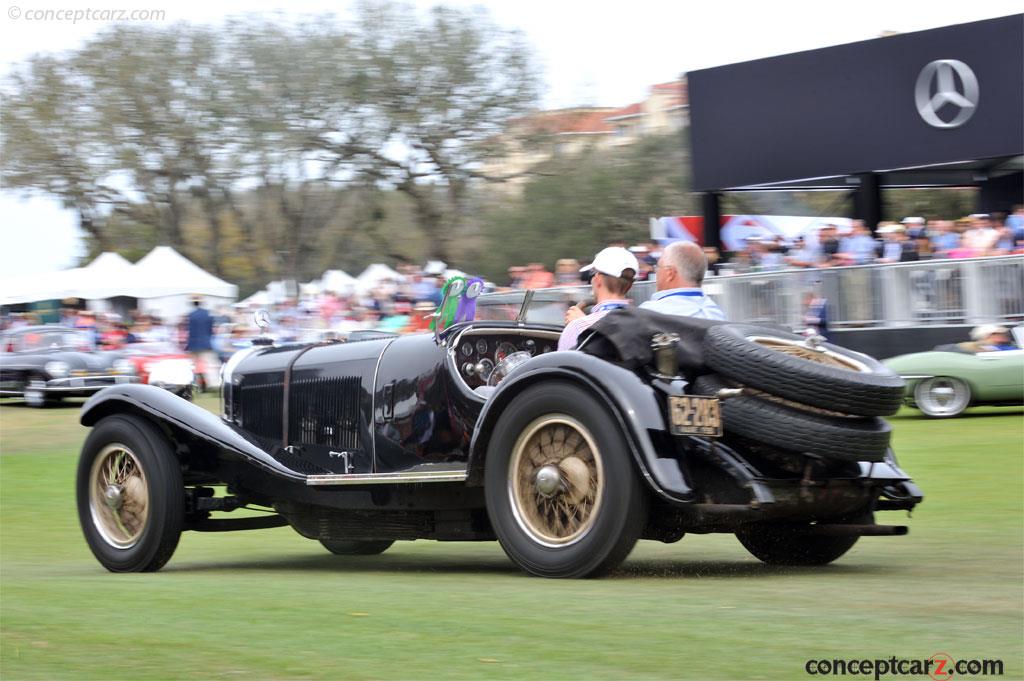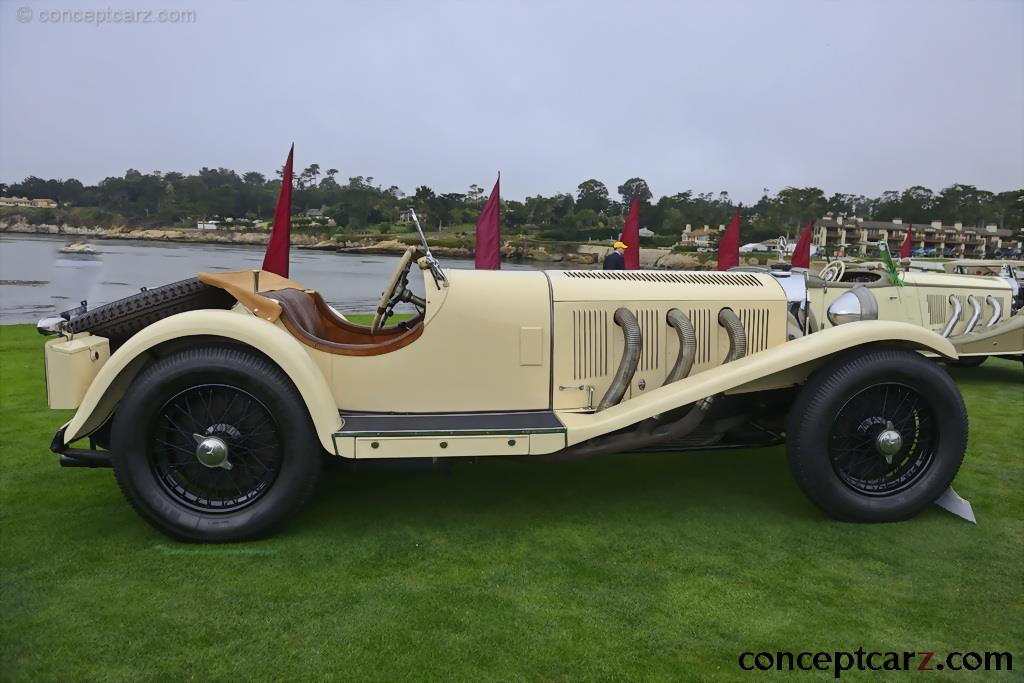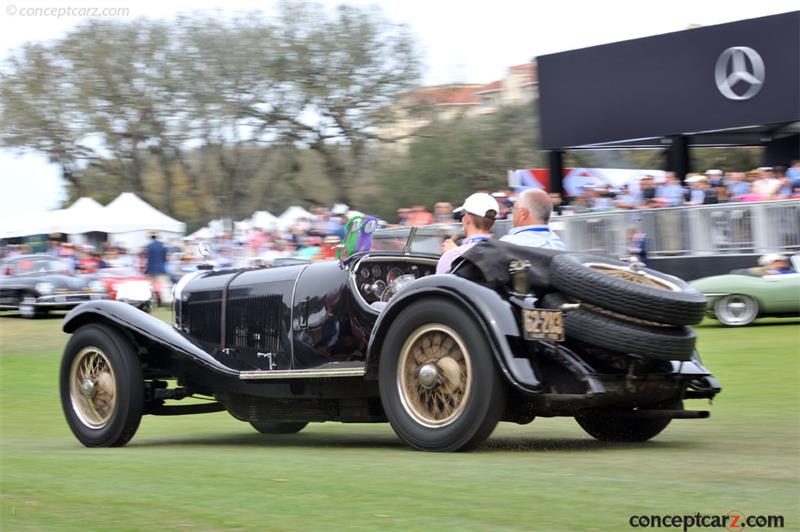In 1926, two of Germany's premier car manufacturers, Daimler and Benz, joined forces, creating Daimler-Benz A.G. It was done in the wake of the post-World War I depression, and the process began in 1925 and was formally consummated on June 26th of 1926. The two companies' manufacturing, product lines, and management were rationalized and integrated. A new logo was created to symbolize this union - a three-pointed start inside of a circle with the names 'Mercedes' and 'Benz' around it, which was bordered by a pair of laurel branches. The 'Stuttgart' cars were built at the Daimler factory in Stuttgart, while the 'Mannheim'-designated Mercedes-Benz vehicles were built at the Benz Works facilities in Mannheim, Germany. Both companies had a passion for creating vehicles that embodied a sporty persona, and this union only amplified this desire. The models created in the years following the merger between Daimler and Benz paved a clear road for the development of future sporting cars that would wear the three-pointed star, some of which was Mercedes-Benz's most popular and historically significant automobiles.
Roadster
Chassis #: 36385
Engine #: 78782
View info and historyThe Typ S was designed by Ferdinand Porsche in 1927 before he left to found his own company. Engineering talents of Hans Nibel and Fritz Nallinger were also instrumentation in the development of the Typ S, a vehicle that forever establish the credentials of Mercedes-Benz at the pinnacle of high-performance luxury automobiles. The Mercedes-Benz Typ S was lower than its predecessor, the Model K (K for 'Kurzer Radstand' meaning short wheelbase), itself a short-wheelbase version of the Typ 400 and a variant of the Typ 630. The 400 had a 4-liter six while the 630 engine displaced 6.3-liters. The Typ S continued to use the K's 3,410mm wheelbase size that incorporated a 'unit' engine and transmission design with rigid mounts that provided cross-bracing and a jointed torque tube drive to the back axle. The size and weight of the engine contributed their own rigidity to the chassis structure. Numerous modifications were made to the single overhead-camshaft six-cylinder engine with its displacement size increased to 6,800cc, along with larger valves, dual carburetors, a modestly increased compression ratio, a larger supercharger that delivered 7-psi boost when engaged, and its cylinder block was constructed of a lightweight material called silumin. The engine was rated at 26/120/180 horsepower (denoting the engine's taxable, naturally aspirated, and supercharged horsepower ratings) and top speed was approximately 90 mph. Servo-assisted brakes provided the stopping power. Mercedes-Benz produced 124 examples of the Typ S and 114 of the Typ SS. Lightweight two- and four-seater coachwork was built by Sindelfingen and Europe's finest coachbuilders. 
38/250 Roadster by Sindelfingen
Chassis #: 36046
View info and historyThe Mercedes-Benz SSK (W06) chassis was built from 1928 through 1932 with fewer than forty examples built. SSK was an abbreviation of Super Sport Kurz meaning 'Super Sport Short' due to its chassis being 19 inches shorter than the Model S, making it better suited for hillclimbs and short races. Its single overhead camshaft straight-6 engine was a 7-liter unit fitted with a Roots-type supercharger and producing between 200 to 300 metric horsepower and over 500 lb-ft of torque depending on the state of tune. With a top speed approaching 120 mph, the SSK was the fastest production car of its era. The supercharger was engaged via a clutch by fully depressing the throttle pedal and giving it an extra push. The supercharger clutch was disengaged when the throttle was released. Competition success was rampant, with Rudolf Caracciola and Christian Werner winning the 1928 German Grand Prix and Carracciola winning the 1929 TT, the 1930 Irish Grand Prix and both the German Grand Prix and the Mille Miglia in 1931. The SSK won the 500 Miles of Argentina in 1929, and the 1929 and 1930 Cordoba Grand Prix.
At the end of the 1931 season, Mercedes-Benz was forced to retire due to the global financial crisis caused by the Stock Market Crash of 1929. Of the handful of SSK models built, very few have survived as many were involved in accidents, destroyed, or scrapped in period. Several were reconstructed and many replcias have been created, sometimes around original parts, causing authenticity to be troublesome.
by Daniel Vaughan | Sep 2021

Roadster
Chassis #: 36385
Engine #: 78782
View info and history

38/250 Roadster by Sindelfingen
Chassis #: 36046
View info and history
At the end of the 1931 season, Mercedes-Benz was forced to retire due to the global financial crisis caused by the Stock Market Crash of 1929. Of the handful of SSK models built, very few have survived as many were involved in accidents, destroyed, or scrapped in period. Several were reconstructed and many replcias have been created, sometimes around original parts, causing authenticity to be troublesome.
by Daniel Vaughan | Sep 2021
Related Reading : Mercedes-Benz SSK History
In 1928 the Mercedes SSK was introduced and commonly referred to as The Mighty Mercedes and The Fastest Sports Car in the World. The name SSK stands for Super Sport Kurz, German meaning short. The naming convention for the SSK typically has numbers associated with them, such as 700 and 710. This represents the engine capacity, 7.0 liter and 7.1 liter respectively. It used a modified version of....
Continue Reading >>
Continue Reading >>
Similarly Sized Vehicles
from 1931
1931 Mercedes-Benz SSK Sport II Vehicle Profiles
Recent Vehicle Additions
Performance and Specification Comparison
SSK Specification Comparison by Year
Year
Production
Wheelbase
Engine
Prices
116.10 in.
Related Automotive News

Mercedes-Benz is an Automotive Sponsor of the 2018 Mille Miglia: Continuation of an excellent partnership
In the coming year Mercedes-Benz will continue its commitment as an Automotive Sponsor of the Mille Miglia. This has just been announced by the Stuttgart-based brand and the organisers of this classic motorsports event. The close connection between the...

Mercedes-Benz Classic At Solitude Revival 2017 In Stuttgart: At The Centre Of The Brand's Racing History
At the fifth Solitude Revival, Mercedes-Benz Classic will bring the great age of motorsport back to life on the legendary Stuttgart circuit with famous racing vehicles and drivers. Among the vehicles on show are the Mercedes-Benz Model S from 1927 and...

Sportiness In The Brand DNA: Game-Changer With Mercedes-Benz At Goodwood Festival Of Speed 2017
With a dozen racing cars and sporty vehicles from over 100 years, Mercedes-Benz Classic sums up the motto of this years Goodwood Festival of Speed Peaks of Performance – Motorsports Game-Changers celebrates competition vehicles that have written...

120 years of motor sport at Mercedes-Benz take centre stage at the Goodwood Festival of Speed 2014
Addicted to Winning at this years Goodwood Festival of Speed, Mercedes-Benz looks back on some fascinating racing victories of the last 120 years
The unique motor sport heritage of the Mercedes-Benz brand is being celebrated with an exclusive i...

'Motor Klassik Award 2013': Five Awards for Mercedes-Benz
Victory in the categories Classics up to 1930, Classics 1947-1961, and 2012 Auction Car
Classics of the future G-Class wins in the Off-Roader category and the CLS Shooting Brake wins for the Luxury Segment
More than 22,000 M...






























